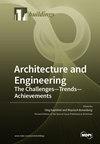建筑外墙空心缺陷区传热特性的实验研究
IF 3.1
3区 工程技术
Q2 CONSTRUCTION & BUILDING TECHNOLOGY
引用次数: 0
摘要
红外检测越来越广泛地应用于建筑物的无损检测领域,用于检测建筑物外墙表面是否存在缺陷。在很多情况下,有必要获取更多有关缺陷的信息,如缺陷深度,以便评估缺陷的严重程度并进行修复。本文根据建筑外立面完好区和缺陷区的传热特性,推导出空洞缺陷深度的理论公式,并定量总结了不同形状、大小和空洞厚度的缺陷对建筑外立面温度分布的影响。首先,推导出了空洞缺陷深度的理论计算公式以及影响外部热源激发建筑外立面温度梯度分布的因素,并对其进行了边界条件限制。其次,制作和设计了三组包含不同形状、尺寸和空腔厚度的镂空缺陷的物理建筑外墙模型,并搭建了实验平台。根据缺陷区域的温差,得到了自然光环境下镂空缺陷的红外热成像图和温度特性曲线,并对其进行了拟合,同时分析了尺寸、形状和空腔厚度对表面温度分布的影响。最后,通过对 14 种形式的空洞进行实验模拟,验证了适用于建筑外墙的缺陷深度理论公式。实验结果表明,修正后的缺陷深度计算公式与实际缺陷深度一致,可以有效地对建筑立面的空鼓缺陷进行三维定位,并与从获得的红外热图像中提取的缺陷尺寸相结合。本文章由计算机程序翻译,如有差异,请以英文原文为准。
Experimental Study on Heat Transfer Characteristics of Hollowing Defect Areas on Building Facade
Infrared detection is more and more widely used in the field of non-destructive testing of buildings to detect whether there is a defect on the surface of the building facade. In many cases, it is necessary to obtain more information about the defect, such as the depth of the defect, so as to evaluate the severity of the defect and repair. The theoretical formula of hollowing defect depths was derived in this paper based on the heat transfer characteristics of the intact and defective areas on the building facade, and the influence of defects with different shapes, sizes and cavity thicknesses on the temperature distribution of the building facade was summarized quantitatively. Firstly, the theoretical formula of the hollowing defect depth and the factors affecting the distribution of the temperature gradient on the building facade excited by external thermal source was derived and restricted by the boundary condition. Secondly, three sets of physical building facade models that contained hollowing defects with different shapes, sizes and cavity thicknesses were fabricated and designed, and the experimental platform was built. The infrared thermograms and the temperature characteristic curves of the hollowing defect in a natural light environment were obtained and fitted according to the temperature differences of the defective area, while analyzing the influence of the size, shape and cavity thicknesses on surface temperature distribution. Finally, the theoretical formula of the defect depth that is applicable to the building façade was validated through the experimental simulation of 14 forms of hollowing. The experimental results demonstrated that the revised formula of defect depth is consistent with the actual defect depth, and the three-dimensional positioning of the hollow drum defect of the building facade can be effectively carried out and combined with the defect size taken from the obtained infrared thermal image.
求助全文
通过发布文献求助,成功后即可免费获取论文全文。
去求助
来源期刊

Buildings
Multiple-
CiteScore
3.40
自引率
26.30%
发文量
1883
审稿时长
11 weeks
期刊介绍:
BUILDINGS content is primarily staff-written and submitted information is evaluated by the editors for its value to the audience. Such information may be used in articles with appropriate attribution to the source. The editorial staff considers information on the following topics: -Issues directed at building owners and facility managers in North America -Issues relevant to existing buildings, including retrofits, maintenance and modernization -Solution-based content, such as tips and tricks -New construction but only with an eye to issues involving maintenance and operation We generally do not review the following topics because these are not relevant to our readers: -Information on the residential market with the exception of multifamily buildings -International news unrelated to the North American market -Real estate market updates or construction updates
 求助内容:
求助内容: 应助结果提醒方式:
应助结果提醒方式:


